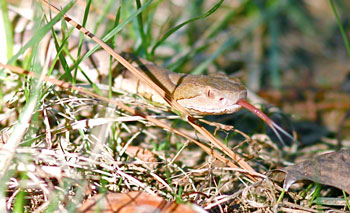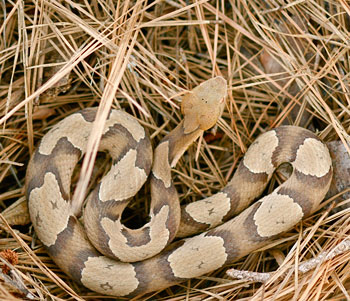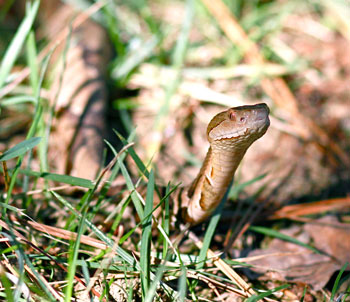 by Mary Parker Sonis
by Mary Parker Sonis
North Carolina leads the nation in two distinct categories: We produce the finest basketball players in the country and we hold the dubious distinction of leading the nation in snakebites. This bad boy is responsible for the majority of those bites. The copperhead, Akistrodon contortrix, is the only venomous snake in the Chapel Hill area. Anyone who insists that they have seen the more venomous water moccasin in our region is mistaken. The water moccasin is related to the copperhead, but they do not live here.
Let’s start with the basic facts. The copperhead is a medium-sized pit viper. Most adults do not exceed three feet in length, but they are quite stout snakes and tend to grow in girth with age. They have the classic triangular pit viper head in a solid copper hue. A heat-sensitive pit is clearly visible between the eye and the nostril on each side of the head. The pit enables the copperheads to locate warm-blooded prey in their immediate vicinity. The diet of the copperhead includes toads and frogs, lizards, large insects and small rodents.

The coloration of the copperhead is varied, but most southern copperheads have dark hourglass markings on a sand background. The shades of brown may be darker or lighter, but the markings are rather classic. Some individuals may have broken bands or an occasional dark spot on the light background.
The eye has an elliptically shaped pupil, much like a cat, but it is inadvisable to make your identification on this observation, as you would need to get a bit too close. Baby copperheads look exactly like their parents, except that they possess a sulfur-colored tail, which they use as a bright lure to attract small reptiles.

Looking at the photograph, you may wonder how so many people get bitten by such a boldly patterned, obvious creature. When viewed on leaves, the copperhead’s camouflage is superb. You probably walk past them all the time and simply never notice them in the leaf litter. The copperhead is generally an ambush predator. Although it will actively pursue cicadas and beetles in the woods, it is more likely to rely on its excellent camouflage and sit lump-like and silent in the leaves, waiting for some hapless prey to wander by.
It does not rattle in the leaves or quickly flee when a human is near. The copperhead will remain frozen and silent. Most bites occur because people simply don’t see them and step next to them or directly on them. Gardeners get bitten when they reach in with their hands to clear weeds from under shrubs. Fortunately, the venom of the copperhead is relatively weak, and it is extremely rare for a human to die from a copperhead bite. The pain is severe and the venom causes massive swelling, but the bite is not fatal.
There are two other reasons that copperheads bite people so frequently. Copperheads are abundant and they are comfortable in our environment. They are quite at home tucked into your woodpile or hiding beneath the stacked boards of the deck that you have not quite gotten around to finishing. An overturned bucket in your yard is a handy hiding spot to wait for a mouse or shrew.
Now that I have you horrified by the idea of walking in your own backyard, keep in mind that the copperhead is also very willing to bite. Ol’ Chunkhead will not slither away quickly if you put your booted foot next to him in the yard; he will strike. If you’re lucky, he may give you a dry bite. He is simply warning you to go away, smart enough not to waste venom on a creature that he has no intention of eating.

For all the above reasons, the copperhead is hated in North Carolina. Everyone has a horrendous copperhead story. One neighbor’s son was bitten when her child jumped off the family trampoline into the leaf litter, and another neighbor’s daughter was bitten when she ran past that overturned bucket in her own backyard. In the summer, when the daytime heat is extreme, the copperhead comes out at night to hunt, which means you might not notice the resting copperhead in your own driveway.
This snake is not hunting for human prey. It has no more intention of harming you than the shard of glass that embeds in your foot when you walk barefoot through a meadow. A copperhead bite is an unfortunate accident and nothing more. You probably know I’m going to try to convince you not to harm copperheads, so I’ll make my argument.
When it comes to snakes in North Carolina, I have grown very impatient with the “shovel factor.†For some reason, people get out the shovel to kill any and all snakes that are encountered. Most people tell me they have small children they need to protect, and most times they’re wrong about the snake ID. I have been called to identify tiny headless worm snakes, misidentified as baby copperheads. I have been told of people killing beautiful (and very gentle) hognose snakes because they couldn’t take the chance that it was a copperhead. Northern water snakes with their brown bands are regularly targeted. They are a declining species, and non-venomous. One woman killed a young northern water snake in Jordan Lake, where all wildlife species are legally protected. The snake was swimming by, but she thought her children were in danger.
As our fear grows, so do the myths surrounding the object of our fear. A well-educated man told me that many black snakes are actually a “cross-up,†or hybrid, of a black rat snake and a copperhead. Of course, this is utterly impossible. The black snake is an egg-laying snake and a copperhead gives birth to live young. This hybrid is as likely as a chicken-goat hybrid.
So what should you do when you encounter a copperhead? Walk away. The snake will not chase you. I am not a proponent of keeping “hot†snakes. I have no desire to handle them. Just let them alone. An owl or opossum might make a meal of the snake, and the reliable king snake is notorious for eating copperheads, so I think we should simply be aware when we are in the woods, but not interfere with nature.
Still not convinced that the copperhead doesn’t deserve the shovel? Frank Markland of the University of Southern California has isolated a protein in southern copperhead venom called contortrostatin. It’s a protein that shows great promise in destroying breast cancer cells and preventing the spread of these cells to other organs like the lung. The snakes are milked for their venom and the venom is then dried and concentrated. The snakes are not harmed. Many of our commonly used medicines come from natural plant and animal sources. Wouldn’t it be wonderful if North Carolina could use our abundant copperhead population to provide this amazing elixir?
If you are unfortunate enough to be bitten by a copperhead, seek medical attention at once. One handy bit of advice is to remove your rings if bitten on the hand or arm, as the swelling will be extensive. You will most likely not be given CroFab antivenin at the hospital, as the possible side effects of the antivenin are more dangerous than the copperhead venom.
Al Baldwin found the southern copperhead photographed for this article in his own cul de sac. He thoughtfully relocated the snake to a less densely populated area, but brought the snake to my front yard for its glamour shots before releasing the snake back into the wild. Many thanks, Al!
7 replies on “FAUNA: Hidden in Plain Sight”
Lovely article Mary Parker! I am so with you on the shovel thing. Not that it was ever a good idea to kill snakes but we just can’t afford it any more. Too many people – too few animals.
Mary great article! Thanks for everything you do to educate people and protect our beautiful wildlife!
Absolutely fascinating article! I learn so much from your articles.
Terrific article, Ms. Sonis! An excellent counterpoint to the “if it scares you, kill it” behavior that so many people have as they stumble about in nature.
thank you David and Cindy! I was fully prepared for a barrage of terrible snake bite stories..glad to hear that people want to protect even our unpopular wildlife!
Thank you for this! It pains me that anyone would go out of there way to kill something so necessary to our local ecosystem. I will say though in the Durham area, as a snake lover, I did chance upon a moccasin or large venomous snake that wasnt a copperhead near our creek (and it looked nothing like the black snakes i have in my back yard). So, probably rare, but there may be a moccasin or two out there.
I would be willing to bet that the snake you saw in Durham was an older water snake. As they age ..water snakes become melanistic…and lose their markings…they look quite venomous..but they are not. They resemble water mocassins …from the broad head to the dark muted markings..I have been startled by them myself…but each and every time ..it has turned out to be a water snake. Tell me about the snake’s colors…I would love to know if a real Water Moc has made it to our area.